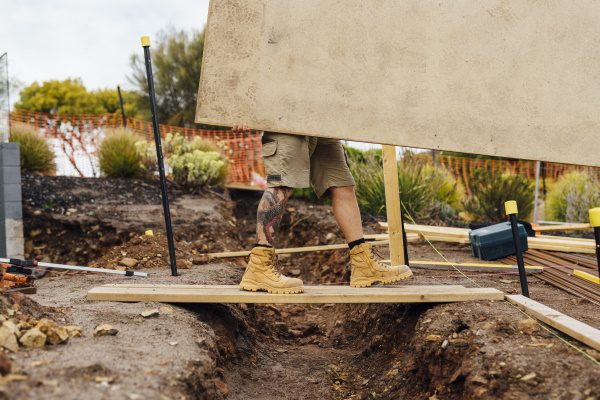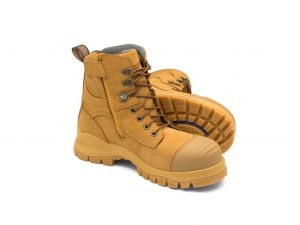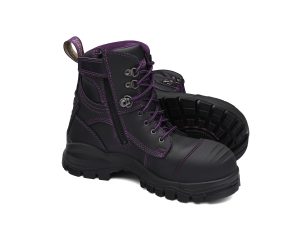Back to work: new year, new boots
While it may seem unnecessary to change boots that look like they’re still fine to wear, work boots don’t last forever. Boots that have been worn out over time will start to lose their protective qualities and safety experts warn that wearing worn out boots with compromised safety features increases general foot ailments, and can become a dangerous health hazard when working in high-risk environments.
According to Blundstone global work and safety range manager Adrian Blandford, Aussies tend to be a sentimental bunch when it comes to their boots, with many boot owners reluctant to give up the soles guarding their feet due to the nostalgic value they hold.

“However, feet are an important factor in overall health, as when they are out of alignment, so is the rest of the body. An unbelievable 100 plus tons of pressure put on feet daily, it is important to wear well-maintained boots with cushioning and arch support to keep you walking comfortably,” he says.
“Foot problems are often due to neglect, lack of awareness and proper care, so ensuring that you replace old, worn out boots without delay is a simple way to avoid pain and damage to your feet, as well as other health issues including back ache and compromised circulation,” continues Andrew.
These five tell-tale signs indicate it’s time to give your boots the boot and head back to work with a new pair.
- Wear and Tear
While some scuffs are manageable and the nature of many peoples’ jobs, it’s important this doesn’t get out of hand. As soon as any protective components, such as a steel, reinforced toe or a metatarsal guard begin to show, it’s time to replace your work boots. This is also true for treads and soles. If they’re significantly worn down or rubbed smooth then they are not providing the required grip and protection. Once the structural integrity of a boot has been compromised to this extent, they will not be compliant to Australian standard AS 2210.3:2019. This means you can be banned from a work site until the boots are replaced.
- Torn Leather
If the leather begins to tear or crack, it could lead to risk of leaking and the boots should be replaced. What’s more, if the leather sags it could mean that the boot has lost its structural cohesion and therefore is no longer supporting your foot which negates the purpose of the boot and may result in compliance failure.
- Impacted Boots
Boots should be replaced if there’s any sign of significant impact or trauma. Depending on the safety boot, there will be signs to tell when a boot has suffered severe damage. Steel toed boots will dent inwards, however with composite materials, the internal structure can be damaged without any signs.
- Exposure to Harmful Substances
If your line of work involves exposure to hazardous or corrosive chemicals and materials and you experience any sign of obvious wear and tear that could lead to leakage then you should change your work boots immediately to avoid any injuries or health issues.
- Discomfort
Most quality boots come with a removeable footbed which is designed to be washable, breathable, and replaceable when necessary. Premium footbeds will provide arch support and cushioning so if your boots become less comfortable than normal, start by checking the condition of the footbed and replace if necessary. If a boot is causing your feet serious discomfort, then it’s not worth risking more serious damage and it’s best to replace them, as it’s important the boot does its job so you can do yours.
“To get the best out of your boots and prolong their life, cleaning your boots thoroughly following the manufacturer’s instructions to maintain the health of the boots and avoid deterioration and damage is important. Ensure when you buy your work boots that they are the right boot for your job and if possible, purchase two pairs so you can alternate and allow any moisture to dry out before wearing,” says Blandford.
To encourage workers to replace their boots in the new year, Blundstone will be running an in-store competition to give customers a chance to win $150,000 cash as well as instant prizes when purchasing a pair of Blundstone leather boots between 11th January and 21st February 2021 from participating stores.
Blundstone work boots are proven to be hardwearing and fit for purpose. For boots that can stand the test of time, consider these favourites from the Blundstone work and safety range:
Blundstone #992 – RRP: $209

- Wheat water-resistant nubuck upper with zip and laceup
- Thermal regulating Bamboo lining
- Moulded TPU bump cap for added leather protection
- XRD® Technology
- Sizes: 5–14 Half sizes: 7.5–10.5
- Safety Standards:
- Standard AS 2210.3:2019
- Standard ASTM F2413-18 Including EH (Clause 5.6)
Blundstone #983 – RRP: $229
- Premium water-resistant leather upper with moulded TPU bump cap for added toe protection
- Removeable luxury footbed with arch support and XRD® Technology
- Durable rubber outsole that is slip, cut and abrasion resistant and can withstand temperatures up to 300°C
- Sizes:
- 5–14
- Half sizes: 7.5–10.5
- Safety Standards:
- Standard AS 2210.3:2019
- Standard ASTM F2413-18 Including EH (Clause 5.6)
Blundstone #600 – RRP: $149

- Built for comfort, with a soft brown leather upper and leather lining.
- Brown premium leather elastic sided boot
- XRD® Technology
- Features hidden stitching in the heel for added durability
- Sizes: 2 – 13, Half sizes: 2.5 – 10.5
- Non-Safety Boot
Blundstone #897 – RRP: $209.00

- Black water-resistant leather upper with zip and lace up
- Purple lining and trim
- Designed for women
- XRD® Technology
- Genuine women’s fit: Sizes 5-11, Half sizes: 6.5 – 9.5
- Safety Standards:
- Standard AS 2210.3:2019
- Standard ASTM F2413-18 including EH (Clause 5.6)
Blundstone boots are available online and in stores via select retailers throughout Australia, and are backed by a 30-day comfort and six-month manufacturing guarantee.
For further information, please visit: www.blundstone.com.au/work-boots
